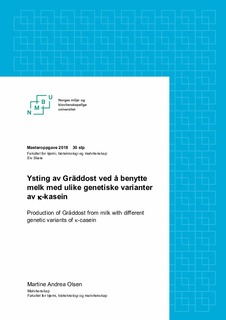| dc.contributor.advisor | Skeie, Siv | |
| dc.contributor.advisor | Ketto, Isaya Appelesy | |
| dc.contributor.author | Olsen, Martine Andrea | |
| dc.date.accessioned | 2018-07-17T08:54:09Z | |
| dc.date.available | 2018-07-17T08:54:09Z | |
| dc.date.issued | 2018 | |
| dc.identifier.uri | http://hdl.handle.net/11250/2505741 | |
| dc.description.abstract | Matindustrien står i dag ovenfor mange utfordringer. Blant annet skal den produserte maten være billig og produksjonen skal være klima- og miljøvennlig. Derfor er det et stort fokus på kostnadseffektivitet i osteproduksjonen og optimal utnyttelse av råvaren melk. For å oppnå dette vil industrien gjerne forsøke å øke utbyttet under produksjon av ost, slik at mengde produkt øker og mengde biprodukt reduseres.
Det er mange faktorer som påvirker osteutbyttet, men den viktigste er sammensetningen av melkekomponentene, og da særlig kasein- og fettinnholdet. Det har vist seg at genetisk polymorfisme av melkeproteiner påvirker denne sammensetningen, der noen genetiske varianter gir et høyere kaseininnhold og et høyere innhold av κ-CN. I dette forsøket er det derfor ystet en Gräddost type ost ved å benytte melk med tre ulike genetiske varianter av κ-CN, mens genotypen til resten av proteinene skulle holdes konstant. Av analysene som ble gjennomfør var det fokus på utbytte, proteolyse og andre kjemiske og sensoriske analyser.
Ystingene gjennomført i denne forsøket viste tydelige forskjeller i Gräddost ystet med de tre genetiske variantene av κ-CN. Grunnet få gjentak og uforutsette situasjoner underveis i forsøket gir disse resultatene bare en grunnleggende forståelse og en interessant grunnmur for videre forskning på dette feltet. Ostene produsert av melk med κ-CN AB gav et høyere tørrstoffinnhold og utbytte, men dårligere sensoriske egenskaper og stor grad av myseutskillelse under lagring sammenliknet med ost ystet av melk med κ-CN AA og κ-CN BB. Innholdet av kasein i forhold til totalt proteininnhold var høyest i melk med κ-CN BB, og osten som hadde de beste sensoriske egenskapene ble ystet av melk med κ-CN BB.
Dette viser at melken som hadde gode ystetekniske egenskaper gav oster med de dårligste sensoriske egenskapene. Grunnet få gjentak og ved ysting av melk fra individuelle kyr var det mange egenskaper som kom frem i dette forsøket som nødvendigvis ikke hadde kommet frem ved ysting av samlemelk. Av resultatene kom det også frem at den ene kua ikke hadde planlagt genetisk variant av β-CN. Dette betyr at sammenlikningsgrunnlaget mellom de ulike genetiske variantene av κ-CN blir svekket. Et forslag til videre forskning er å yste med samlemelk, og undersøke effekten av både κ-CN og β-CN og yste med minimum tre gjentak. | nb_NO |
| dc.description.abstract | The food industry today faces many challenges. Among other things, the produced food must be inexpensive, and the production should be climate and environmentally friendly. Because of this, there is a great focus on cost-effectiveness in cheese production and optimal utilization of milk as a raw material. Because of this the industry would like to increase the yield from the production of cheese, so that the amount of product increases and the amount of by-product decreases.
There are several factors that affects the cheese yield, one of the most important is the composition of the milk components, especially the casein and fat content. It has been shown that genetic polymorphism of milk proteins affects this composition, where some genetic variants gives both a higher casein content relative to the total protein content and a higher content of N-CN. In this experiment, a Gräddost type of cheese has been produced using milk with three different genetic variants of N-CN, this while the genotype of the rest of the proteins should have been kept constant. Of the analyzes that were carried out, there was focus on yield, proteolysis and other chemical and sensory analysis.
The cheesemaking carried out in this study showed clear differences in Gräddost type of cheese with these three genetic variants of N-CN. Due to few repetitive and unforeseen situations along the way, these results provide only a fundamental and interesting basis for further research. The cheeses produced from milk with N-CN AB gave a higher solids content and yield, but poorer sensory properties and a high degree of whey secretion during storage compared to cheese cheeses of milk with N-CN AA and N-CN BB. The content of casein relative to total protein content was highest in milk from cows with N-CN BB, and the cheese with the best sensory properties was from milk with N-CN BB.
This shows that the milk with excellent technological properties gave cheeses with the poorest sensory properties. Because there are few repetitions, and that the milk used came from individually cows, there are many characteristics that appear in this experiment, which necessarily does not arise when mixed milk is used. The results also revealed that one cow did not have the planned genetic variant of E-CN. This leads to a weakened basis of comparison between the different genetic variants of N-CN. A proposal for further research is to collect milk from a larger number of cows, and study the effect of both N-CN and E-CN with at least three repetitions. | nb_NO |
| dc.language.iso | nob | nb_NO |
| dc.publisher | Norwegian University of Life Sciences, Ås | nb_NO |
| dc.rights | Attribution-NonCommercial-NoDerivatives 4.0 Internasjonal | * |
| dc.rights.uri | http://creativecommons.org/licenses/by-nc-nd/4.0/deed.no | * |
| dc.title | Ysting av Gräddost ved å benytte melk med ulike genetiske varianter av κ-kasein | nb_NO |
| dc.title.alternative | Production of Gräddost from milk with different genetic variants of κ-casein | nb_NO |
| dc.type | Master thesis | nb_NO |
| dc.source.pagenumber | 112 | nb_NO |
| dc.description.localcode | M-MAT | nb_NO |

